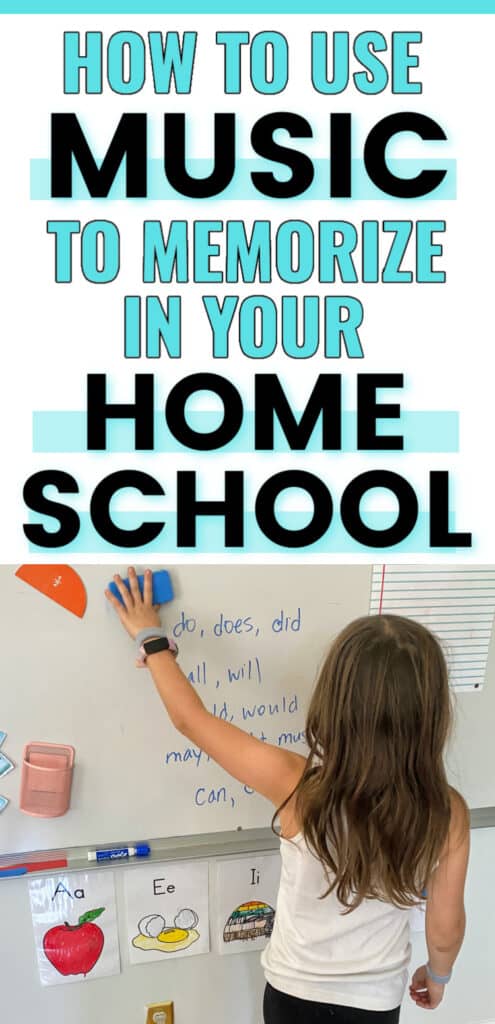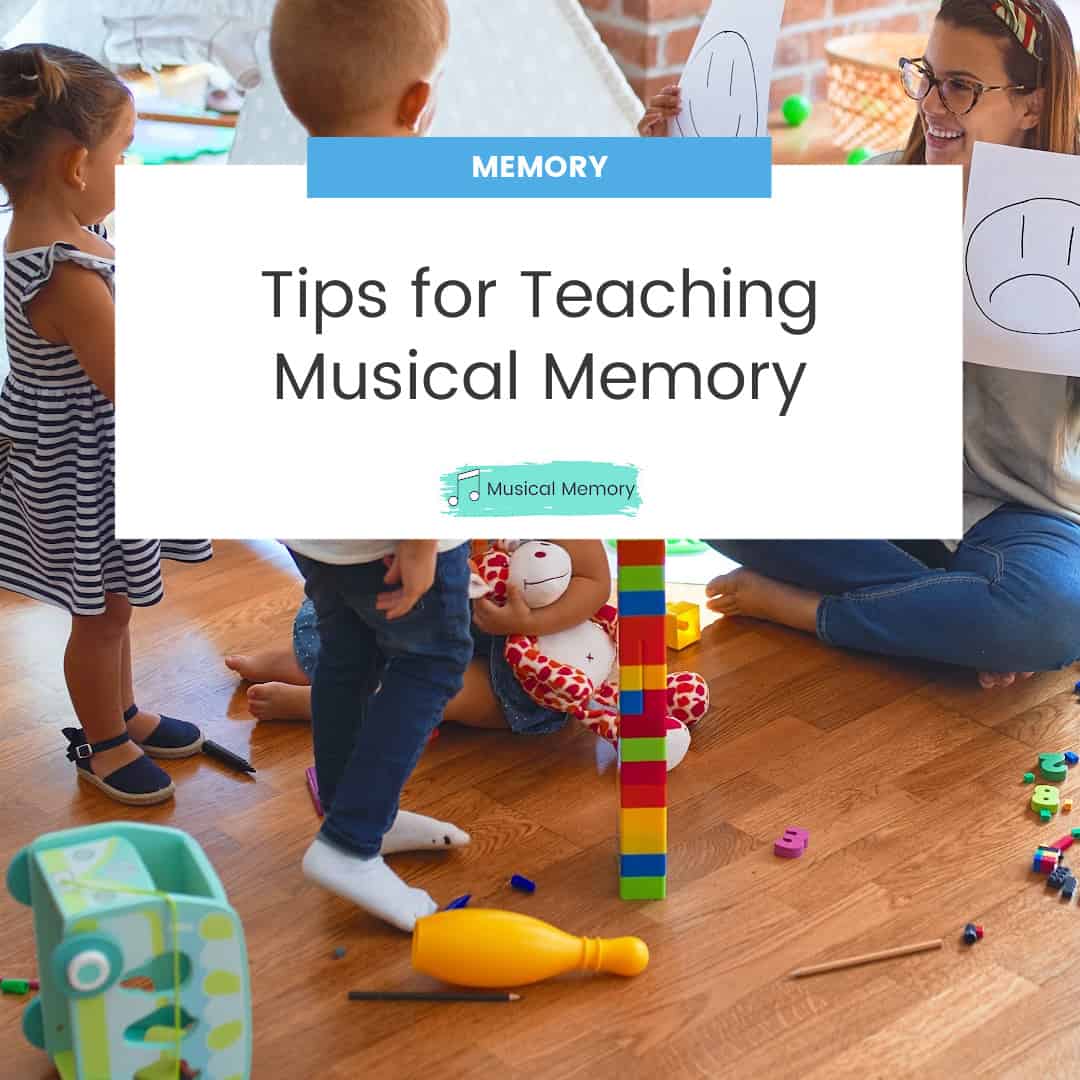It can take a while to figure out how to best incorporate memorization into your homeschool day.
The key to long-term mastery is exposure & repetition in the day-to-day practice. Don’t stress out if your 5 year old can’t pronounce “conjugation” correctly on the 2nd try. Keep playing the songs, keep playing echo games, keep practicing the words slowly and trust the process.
It takes time, but the longer we’ve worked on memorizing (especially through song), the more convinced I am that it’s a valuable part of our curriculum.
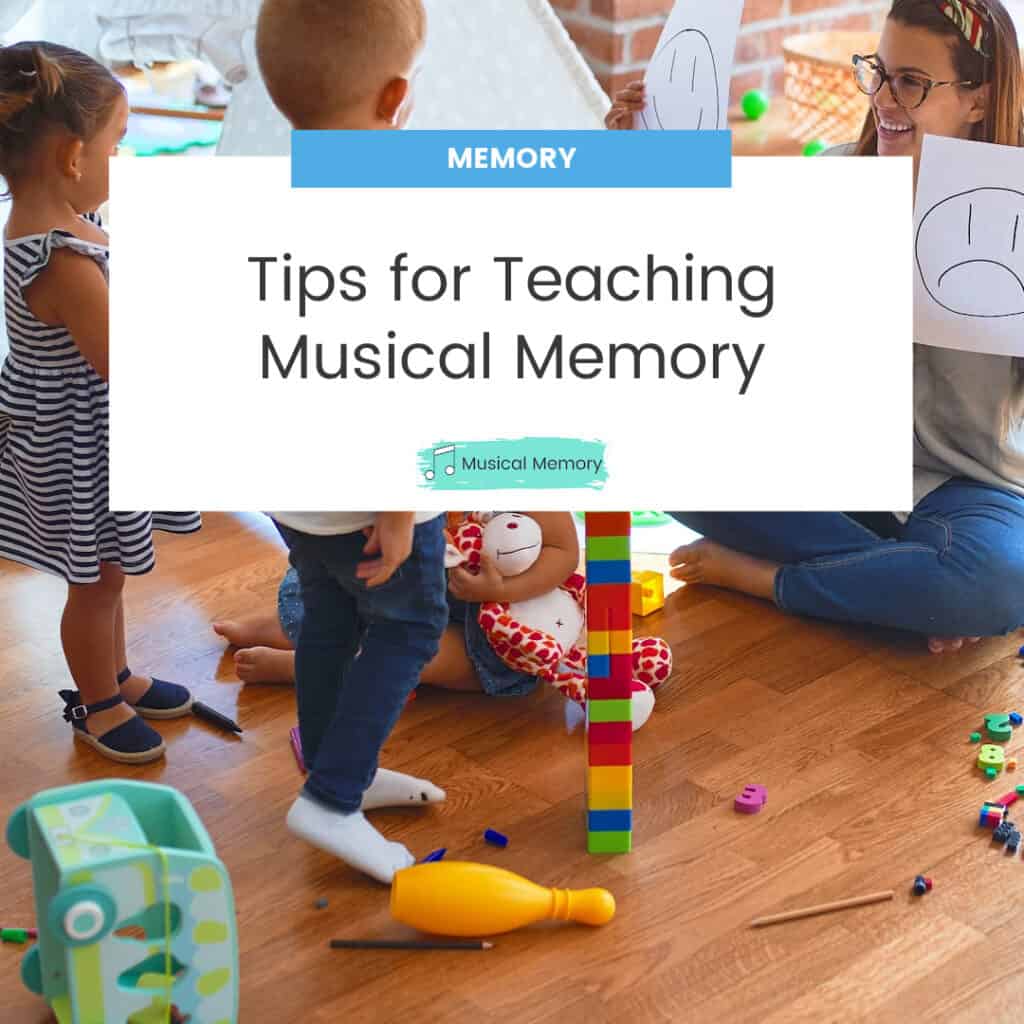
When to Practice
Musical Memory is a GREAT family subject. Kids of all ages benefit in different ways from memorization.
Think through what works well in your homeschool already, and add Musical Memory in a way that makes sense for your rhythms.
If you have lingering breakfasts, print the weekly overview sheets to keep on the breakfast table and turn on the week’s songs the last 10 minutes of the meal.
If you spend a lot of time in the car, keep the printed weekly overview sheets in binders in the car, and practice it during drive time.
If you rotate through working 1-on-1 with children, set up a Musical Memory station with headphones & a CD player where your child can listen independently and follow along with the weekly printable sheets.
If you have lots of young children in your home, announce “Musical Memory Time!!” enthusiastically and bring out a special Musical-Memory-Time activity to keep their hands busy. (Legos, Magnatiles, play dough, beading pasta or cheerios, and puzzles have been a few of our faves!) Just let them play and listen and don’t worry too much about “practicing” it for now. If you play the yearly album and various subject playlists for a year, even your 3 year old will internalize way more than you’d expect. You’ll be shocked how easily he will master it a couple years later.
We’ve done all of the above at various times in our family.
Currently, we work on Musical Memory part of our “morning time” a couple days a week (along with other readings & subjects). The rest of the days, we practice in the car or during a meal or snack time.
Introducing New Songs
Here’s how to introduce new songs for the week.
1. Play the Week’s Songs Once
I like to do this first if I have time. It gets the kids interested and they usually think the songs are fun. They’re generally sort of familiar with some of them because I play them in the background at random times as suggested above.
2. Speak the Words Phrase by Phrase – Kids Echo
For the first song you want to teach, have the kids echo the words after you speak them, phrase by phrase. Just read the text from the printable guide for that week. (Sample guide page pictured below.)

3. Play the Song & Try to Sing Along
I don’t print the text for the kids. We just listen and they try to sing/ mumble along. Since most of the songs are under 30 seconds, it doesn’t take long to play a song a couple times through.
I have all the songs in an mp3 player app on my phone so it’s VERY easy to just pull up that week’s songs and hit play.
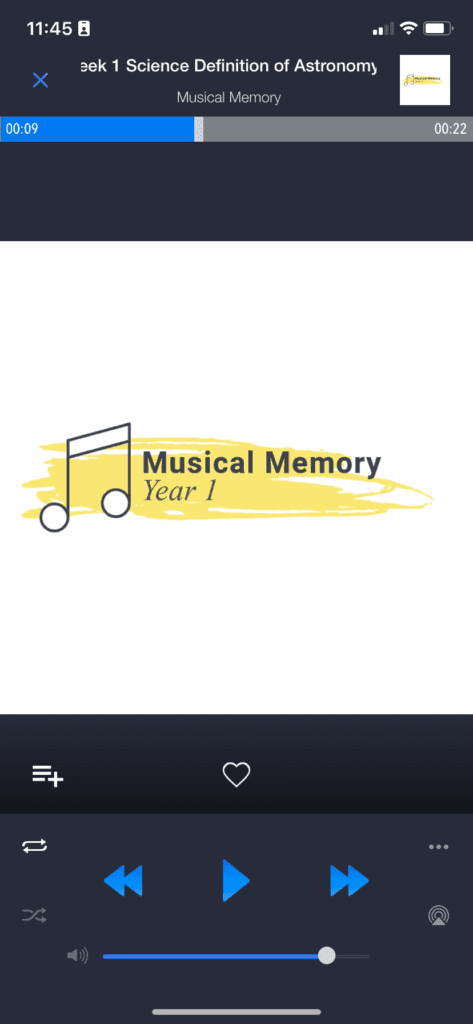
4. Repeat for All 5 songs That Week
On days 2, 3, and 4, I honestly just hit play and the kids listen & try to sing along. Usually during breakfast. Sometimes, later in the car. Simple!
The key to the above process is to keep things fun & moving quickly. If your kids are very young, just do that for one subject per day so the session doesn’t get too long. Don’t get frustrated if they don’t want to repeat the whole thing or make mistakes. Keep your attitude positive. You don’t want Memorization practice to be something they dread.
A positive attitude, exposure & repetition over many years go a long way.
How Much to Practice
The time really varies depending on how you practice the songs. We typically recommend 10-20 minutes on Day 1 to follow the above process. Then, 5-10 minutes a day after that. But… you can definitely just play the songs in the background of the car or play time or meal time and be amazed as your kids pick up the lyrics & start asking questions about all kinds of interesting things.
The songs are mostly less than 30 seconds. (Longer songs that cover more material are typically reviewed over the course of a few weeks int he program.)
So, the pacing is pretty gentle & kids don’t have a problem memorizing the songs quickly.
- Day 1 – 10-20 minutes introducing all new material
- Day 2 – 4 – 5-10 minutes reviewing this week’s material
- Day 5 – 15 minutes reviewing material from previous weeks.
It does help if you play the songs as you drive, play, clean, etc. They go into the kids’ heads almost without them knowing. Then, when you formally sit down to learn a song at a different time, the kids sort of already know them! Kids’ brains are amazing!!
Minimal Prep Games for Practicing Musical Memory
If your family likes using games in homeschooling, here are some easy ideas that work well with Musical Memory.
I like having my Quick Look Subject Overview sheets on hand for review games for reference.
- Dice games – Write 1-6 on a whiteboard or paper and label each number with an action or silly voice. Have the kids roll the dice & practice one memory work item with whatever they roll.
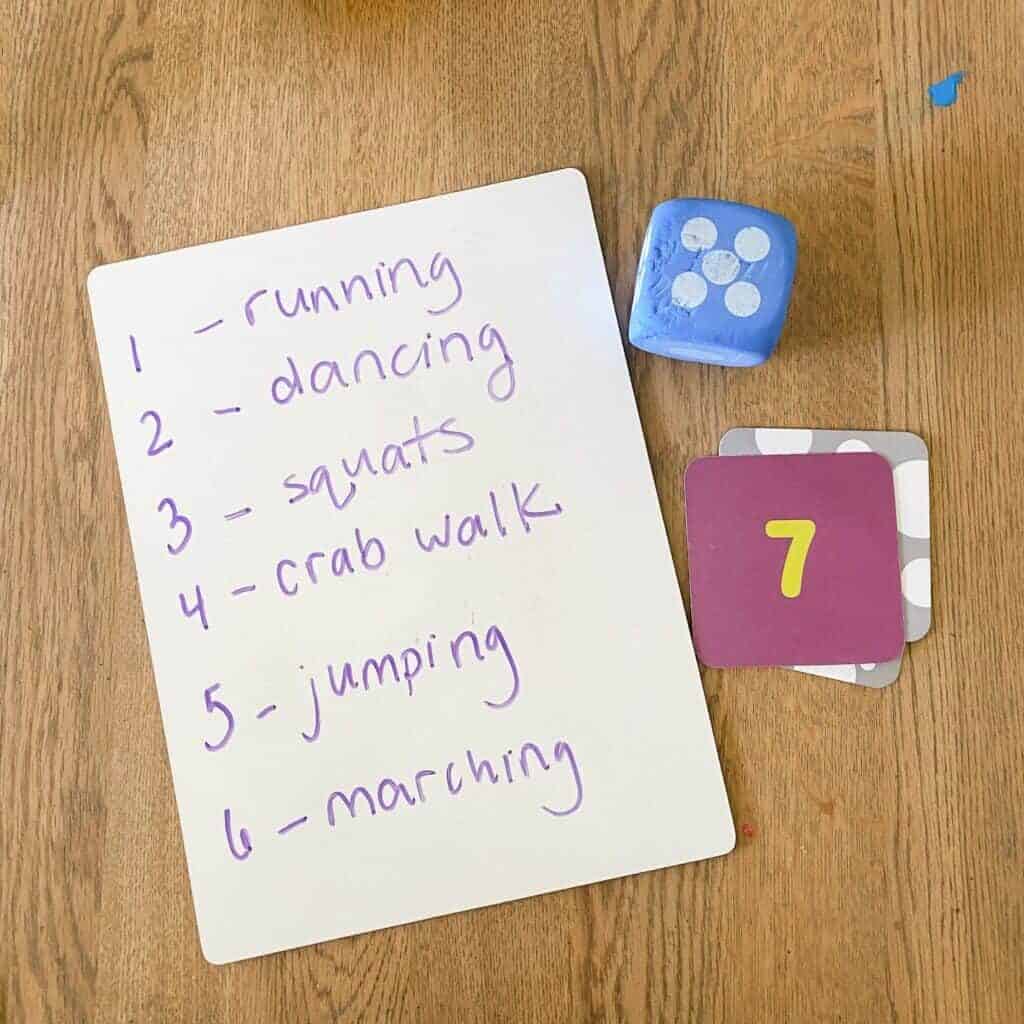
- Tic Tac Toe – One child is X, you are O. (Or have kids play against each other.) If the child can say or sing the sentence correctly, they get to place their X or O. If they get it wrong, the other person gets a turn to try it.
- Build Something – Put a pile of legos, blocks, pattern blocks, tinker toys, brain flakes, etc. in the center of the floor/ table. Whoever can say the memory work gets a few building pieces for each correct sentence. The more than can say, the more they build.
- Basketball – Grab something that can work as a ball (ball, stuffed animal, crumpled up paper) & something that can work as the basket (laundry basket, trash can, etc.). Mark tape on the floor for various points. Have a child say one Musical Memory sentence at a time. If they get it correct, they can shoot a basket.
- Jenga – Label Jenga blocks with weeks and/or subjects. The blocks can say: Math, Bible, Grammar, Latin, etc. Stack them like Jenga and have each person say one sentence from whichever subject block they pull out.
- Activity Memory Work – Say it while jumping on the trampoline, jump-roping, squats, etc. Or with multiple children, have them ride their bikes/ scooters up and down the block and every time they get back to you, they have to check in and say 2 memory items.
- Stick Points – You’ll need a jar of popsicle sticks. Write 1 on 10 sticks, 5 on 7 sticks, and 10 on 5 sticks. For every correct memory work item, the child(ren) pick a stick to see how many points they earned. Play until they earn a certain amount as a group or have children compete against each other if it works in your family.
You can always turn the songs on to help during these games. Basically any game or activity your child enjoys can be turned into a Memory Work game. Find what works for your family.
We mostly do songs or a quick review for our current week’s material Monday-Thursday. Sometimes we do an easy active game if kids are squirrely. (Like the action dice game pictured above.)
During cold weather months, we usually do a fun game on Friday to review several weeks’ worth of materials. To keep things simple, I just pick 1 or 2 games for the semester & rotate between them.
Keep it Fun!
I can not overemphasize how important is to keep your Musical Memory sessions short & fun.
The parent sets the tone. Don’t make it something to “get through.”
Avoid the temptation to snap at your kids for being silly or not taking it seriously. This is the perfect subject to be silly with! Wiggle & dance & let them jump off the furniture while you blast the Musical Memory songs. Let them practice while doing headstands against the wall.
Stick with it, little by little, a few songs at a time. Eventually, you will start to see your child have one lightbulb moment after another as they make meaningful connections between the hundreds of 15-30 second songs they’ve learned and something they come across in their schoolwork or the real world.
